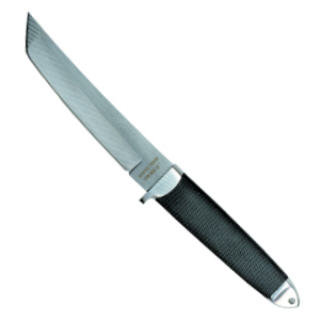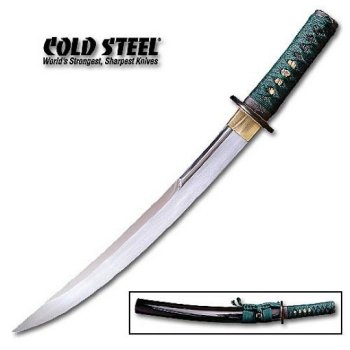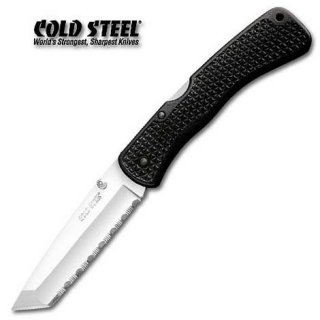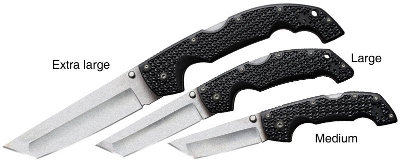
|
THE LIBERTARIAN ENTERPRISE Number 616, April 24, 2011 "Cut off all government transfer payments to billionaires" Attribute to The Libertarian Enterprise You can learn something new every day, if you pay attention.
According to Wikipedia, the proper name for the object in question is "Kamasu Kissaki". Sometimes referred to as an "Americanized" or "westernized" tanto, it is an ancient Japanese design that went out of use during the 15th century, the middle of the the Ashikaga shogunate slightly before the Sengoku period, or the century of the "Warring States". It's a bit hard to understand why. The tanto, as we know it, is a perfect implement for striking through rattan armor and relatively thin metal. Basically, it's a kind of a chisel, except that the chisel edge is set at an angle, it says here, of 60 to 80 degrees. One side of the resulting weapon is also sharp, usually with a subtle curve or "belly". The idea is to keep the blade stout as close to the tip as possible, giving it highly gratifying powers of penetration. As Wikipedia says, the point is actually a second edge on the end of the blade.
This is, after all, a serious and deadly weapon. It's easy to lose sight of that, sometimes, in a rapture of polished metal and sensuous curves. The knife was shown being stabbed through car doors, 55-gallon oil drums, inch-thick plywood, and similar materials without damage to the blade. I've often regretted not buying one, but it was soon joined by various lengths of "Magnum tanto", starting with a nine-inch model that had a stainless steel pommel and a sure-enough oval tsuba or guard. A little bit after that, Cold Steel produced a "mini-tanto", which is my wife Cathy's favorite knife. Hers is a miniature of the original model, but there are specimens out there with the same kind of tsuba as my magnum, and there are "regular" six-inch models with the same feature. Someday, when opportunity and economy converge, they will be mine. They will be mine. After that, there was an explosion of tanto-pointed knives. I can only cover a few here. By far the snazziest is marked on one side of the blade-root "TAYLOR/SETO, SURGICAL, JAPAN" and the other, "DESIGNED BY K. ADKINS". It's a small knife—the blade is only three and a quarter inches long—and at first glance, it looks like a locking folder. In a way, it is, but when you press the thumb-spot at the back of the artificial oosik handle, the blade folds down so that the knife becomes a tanto-tipped push-dagger (about which I'll do an article another time). Oosik, in case you don't know, is the fossilized bone, called a "baculum", from the penis of a walrus. If my flatbed scanner was working right now, I'd show you a picture—of the knife, not the penis. The fun thing is that I have two of these knives, one for each fist. Later on, Cold Steel made what I consider to be lesser tantos, among them several models called "Oyabun". The blades aren't polished as prettily, and the oval guard is rubber, integral with the grip, which does not have a headcracking pommel. But these are good knives that would be as efficacious for self-defense as any other nine-inch knive.
 Columbia River Knife and Tool (CRKT) makes a similar knife, the "Ed Halligan Engineered 'Stiff K.I.S.S.'" which I've found extremely useful, but their "Carson Design M16-10KZ" is a work of art, a three- inch folder with a double safety lock (which takes a bit of getting used to), a comfortable ergonomic handle, and beautifully profiled blade. For now, that leaves a pair of very inexpensive but interesting blades, an 11-inch tanto and a 17-inch wakizashi or short-sword, both marked with a stylized "HK" in a shield, and "Stainless, China". They're pretty good quality considering I paid twenty bucks for the pair. I've postponed this column for weeks because something I ordered from Atlanta Cutlery got backordered. It's a very plain six-inch blackened steel tanto with a cord-wrapped handle from some outfit called Glacier Bay. If I ever get it, I'll discuss it here another time. By the way, chastized earlier this week for a knife pun I posted online, here's another. What sort of knives do you get when you wear sandals? Answer follows below.* Meanwhile, I'll leave you with a mystery. On some PBS documentary about paleontology in the Gobi desert, I saw a knife that made very good sense to me. Its handle was of wood, riveted on like a cheap kitchen knife. But the plain steel blade was as wide as that of a butcher knife, and it ended in a tanto point, perfect for the assigned task. I have never seen its like since then, but I want one.
Author's note: manufacturers and purveyors of knives who wish to see their products reviewed by this column are invited to write to me at [email protected] for mailing details. In all cases, merchandise will remain the property of the author. Those items that I especially like may end up in the hands of the characters of my novels.
TLE AFFILIATE
|
 Imagine my surprise when I recently discovered that the tanto,
that most Japanese of all knives isn't really Japanese at all—at
least not recently, and at least not the form we're most familiar with—but
fully as American as fish and chips, hot and sour soup, and
pizza.
Imagine my surprise when I recently discovered that the tanto,
that most Japanese of all knives isn't really Japanese at all—at
least not recently, and at least not the form we're most familiar with—but
fully as American as fish and chips, hot and sour soup, and
pizza.
 "Modern" tantos, on the other hand—those designs younger than
six hundred years old—have a front end more or less like a like a
fileting knife, with a long edge curving up somewhat abruptly to the
tip.
"Modern" tantos, on the other hand—those designs younger than
six hundred years old—have a front end more or less like a like a
fileting knife, with a long edge curving up somewhat abruptly to the
tip.
 After some consultation with a fellow knife collector, we came to
the conclusion that the first Kamasu Kissaki points we saw were on
custom knives in knife magazines in the 1970s. Soon after that, Cold
Steel's first commercial tanto arrived with a gleaming six-inch blade,
black synthetic rubber handle, and polished brass bolster and pointed
pommel meant, I believe, for a star-fracturing backhanded blow to the
skull.
After some consultation with a fellow knife collector, we came to
the conclusion that the first Kamasu Kissaki points we saw were on
custom knives in knife magazines in the 1970s. Soon after that, Cold
Steel's first commercial tanto arrived with a gleaming six-inch blade,
black synthetic rubber handle, and polished brass bolster and pointed
pommel meant, I believe, for a star-fracturing backhanded blow to the
skull.
 Cold Steel makes a lot of other tantos, including a line of fairly
big folders, the largest of which might just be as good a pocket knife
as my long-trusted Spyderco Endura. And then there's "The Spike", a
thick, sharpened splinter of steel intended, I think, as a "neck
knife".
Cold Steel makes a lot of other tantos, including a line of fairly
big folders, the largest of which might just be as good a pocket knife
as my long-trusted Spyderco Endura. And then there's "The Spike", a
thick, sharpened splinter of steel intended, I think, as a "neck
knife".